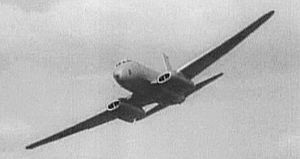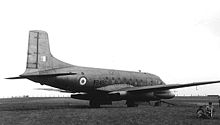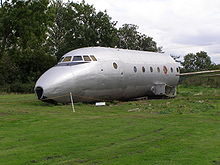Avro Ashton Video - Picture

|
|
Avro Ashton
Ashton

Picture - Avro Ashton prototype
Role: experimental airliner
Manufacturer: Avro
First flight: 1 September 1950
Number built: 6
Developed from: Avro Tudor
The Avro 706 Ashton was a British prototype jet airliner made by Avro during the 1950s. Although it flew nearly a year after the de Havilland Comet, it represented an experimental programme and was never intended for commercial use.
Design and development
The Avro 689 Tudor 9 was based on the Avro 689 Tudor II piston-engined airliner using experience on work on the Rolls-Royce Nene jet-powered experimental variant the Tudor 8. The Avro Type 689 Tudor 9 later renamed the Avro 706 Ashton was a four-jet engined research aeroplane powered by Rolls-Royce Nene engines paired in wing nacelles.

Picture - Avro Ashton 1 at Woodford Aerodrome, Cheshire, in May 1959
Six were built using the Tudor airframe, beginning with the conversion of Tudor I initially powered by Nene 5 engines. The Ashtons that followed incorporated the upgraded Nene 6 and featured an enlarged, "square-shaped" tail fin and tricycle landing gear replacing the original "taildragger" configuration. The engines were tightly grouped in two nacelles that were faired neatly into the wing but also extended below in streamlined pods. The four-engine arrangement compensated for the low thrust of the early jet engines and greatly reduced asymmetric affects in an "engine-out" scenario.
The crew was composed of a pilot, co-pilot, navigator, flight engineer and radio operator clustered together in the cockpit and front compartment of the Ashton. A larger complement could be carried in the spacious fuselage when warranted.
Operational history

Picture - Avro Ashton fuselage at the Newark Air Museum
Production was completed rapidly through modifications of surplus Tudor 2 airframes with a single example each of the Ashton 1 (WB490), Ashton 2 (WB491), Ashton 4 (WB494) and three Ashton 3s (WB492, WB493 and WE670), all built by Avro at Woodford. Test flights began in 1950 with evaluations of jet operations, navigation and at least one Ashton (Mk 4) tested bombing equipment with two streamlined underwing bomb containers fitted.
Despite being one of the first jet-engined air transports, the Ashton was engaged in primarily experimental work and was soon eclipsed in technology by the first of the full scale production airliners, the de Havilland Comet.
Ashton WB491 was modified with an under-fuselage mounting for testing turbine engines. It was used by Rolls Royce for trials with the Conway and Avon.
Bristol Siddeley used Ashton WB493 as a testbed for its Olympus turbojet. The aircraft was fitted with two Olympus engines under the wings, outboard of the Nenes. Later the port Olympus was replaced with a Bristol-Siddeley Orpheus for trials.
Survivors
The fuselage of the Ashton 2 (WB491) is preserved at Newark Air Museum, UK.
Specifications (Avro Ashton)
General characteristics
Crew: 5
Length: 89 ft 6.5 in (27.31 m)
Wingspan: 120 ft 6 in (36.58 m)
Height: 31 ft 3 in (9.53 m)
Wing area: 1421 ft² (39.5 m²)
Max takeoff weight: 82,000 lb (37,200 kg)
Powerplant: 4x— Rolls-Royce Nene 6 turbojet, 5,000 lbf (22 kN) each
Performance
Maximum speed: 439 mph (707 km/h)
Range: 1,725 mi (2,775 km)
Service ceiling: 40,500 ft (12,300 m)
Rate of climb: 2,900 ft/min (880 m/min)
Notable appearances in media
Avro Canada Jetliner
Related development
Avro Tudor
Bibliography
Jackson, A.J. Avro Aircraft since 1908. London: Putnam Aeronautical Books, 2000 (revised edition). ISBN 0-85177-797-X.
Winchester, Jim. X-Planes and Prototypes. London: Amber Books Ltd., 2005. ISBN 1-904687-40-7.
Avro Ashton Pictures and Avro Ashton for Sale.
Living Warbirds: The best warbirds DVD series.
Source: WikiPedia